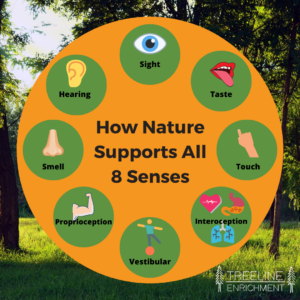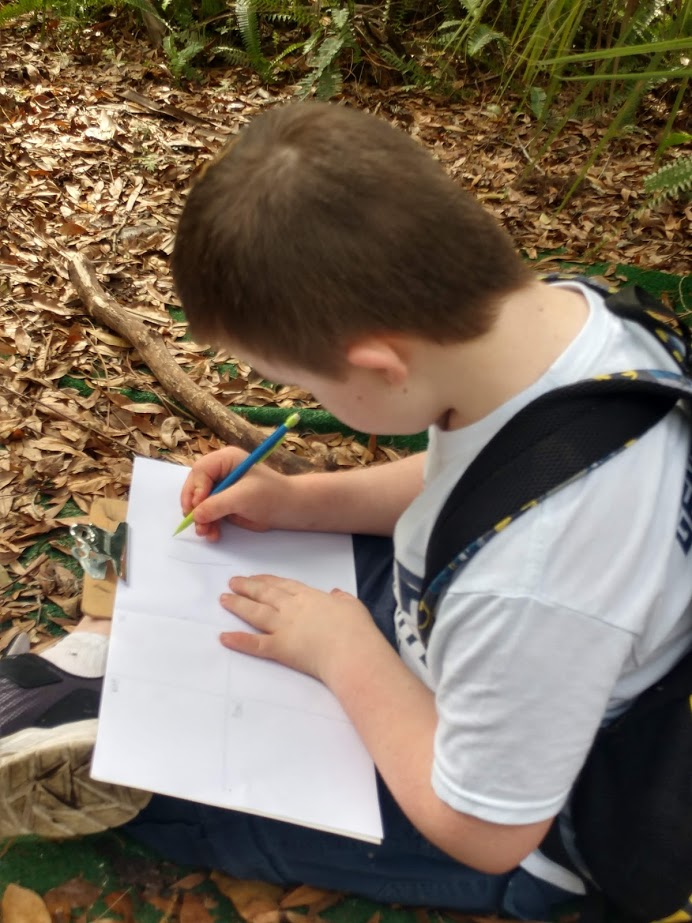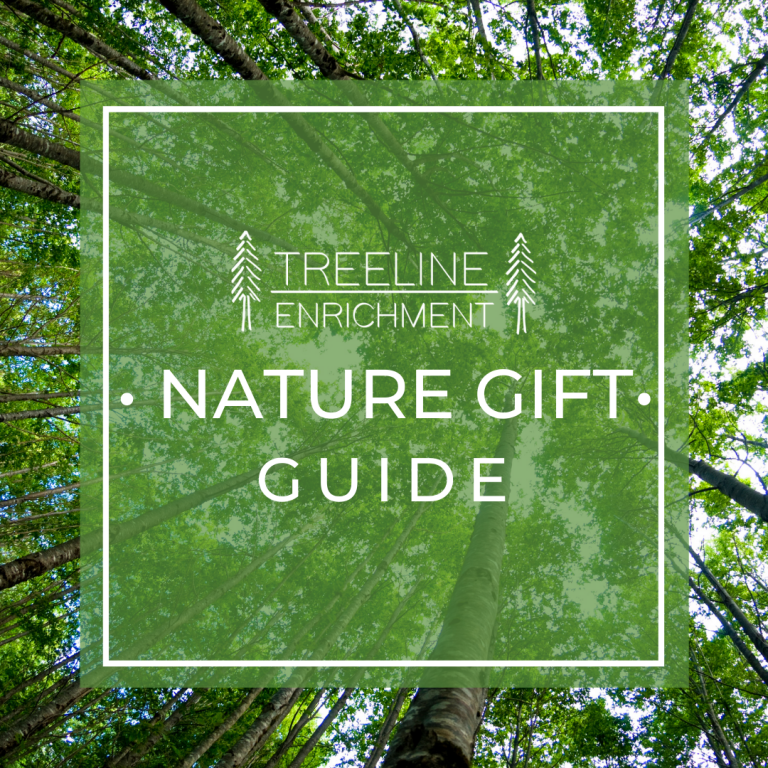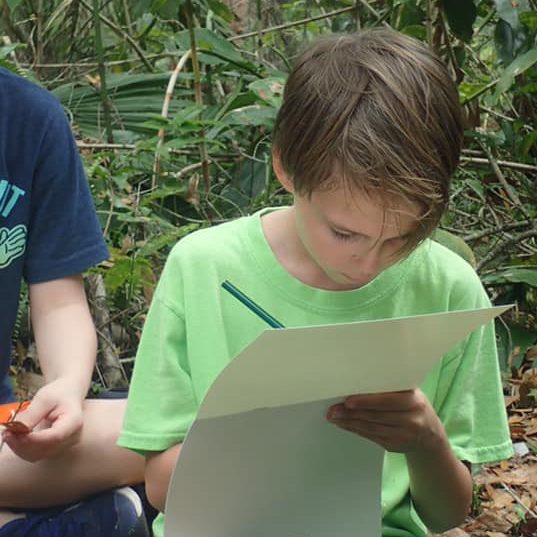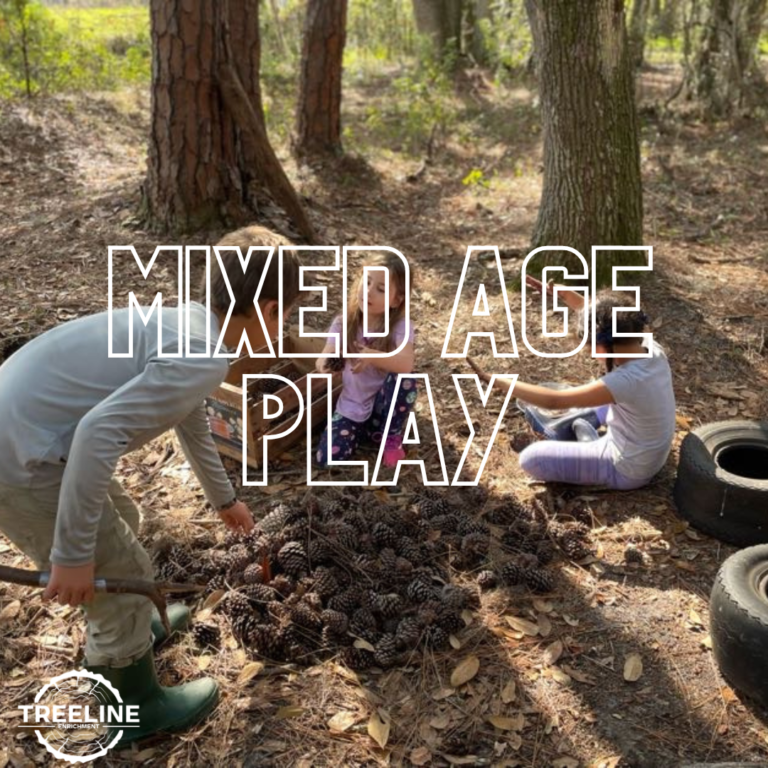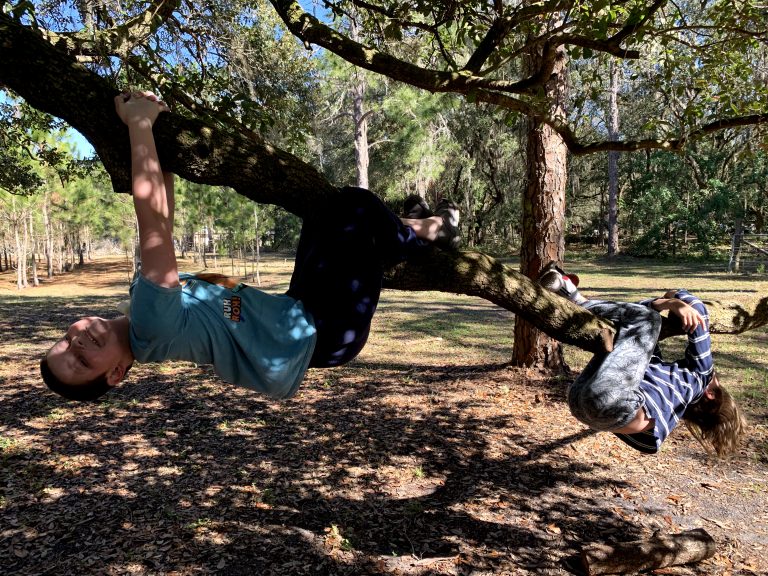How Nature Supports All 8 Senses
Did you know that the way a body senses things internally and externally plays a huge role in creating a sense of self? The Lab of Action and Body at the University of London puts it this way: “Awareness of one’s’ body is intimately linked to self-identity, the sense of being ‘me’”
As a parent, I am sure you want to support your child’s senses so that they can become their best self. Enriching your child’s sensory input may sound overwhelming, but it can be as simple as playing outside with your family! Come along as we explore the sensory systems and discover how nature supports all 8 senses.
Nature is a tremendous resource to foster growth and development of every sense. The simple act of providing unrestricted outdoor play for children with plenty of time to climb trees, catch frogs, and use the imagination sets the scene for rich sensory experiences. In addition we want to provide you with some specific play suggestions to spark your creativity.
“Awareness of one’s’ body is intimately linked to self-identity, the sense of being ‘me’”
What are the senses?
Think back to elementary school and you may remember learning about the five senses. I am going to tell you something that may blow your mind – there are actually eight senses. In addition to the commonly known five – Hearing, taste, sight, smell and touch – there are also three other senses – Vestibular sense (knowing where you are in space), proprioception (knowing where are body parts are grading their movement) and interoception (the bodies internal signals). Let’s dig into each system.

Vestibular System
The vestibular system is located in the inner ear and helps the body to know where it is in space. Essentially, it is responsible for balance and normal movement. Additionally, other sensory systems such as vision, rely heavily on information coming from the vestibular system to function efficiently. Input to the vestibular system can be either calming or alerting and its effects can last for many hours.
A healthy vestibular system is supported by moving in all directions. Children benefit from being active and engaging in multi-directional movement. Picture the head nodding up and down, turning side to side and titling left and right.
Here are some great ways to promote healthy movement outdoors:
- Going on a Bear Hunt – Actively participating in this song is a fun way to get bodies moving in many directions. As children explore their environment by going under, over and around obstacles, they are getting the important input they need.
- Hammock – A portable hammock is a simple and fun way to provide swinging movement. Not only does it provide good sensory input, but it provides a calming retreat. For a special treat, read a book with your child with both of you in the hammock.
- Fort building– The process of building a fort involves lots of up and down and side to side movement. Work together to gather sticks and materials and then create a structure.This activity utilizes lots of movement in the context of meaningful play.

Proprioception
This often unknown sense is information taken in through joints, tendons, and muscles about movement and body location. It is how we know where our body parts are without looking at them. As well as that, it informs our muscles to use the appropriate amount of force for a particular action. For instance, picking up a butterfly will use much less force than picking up a rock.
Providing the body with input to the proprioceptive system can have an organizing effect on the brain. Occupational therapists often call this type of input, heavy work.
Here are some ways to provide some proprioceptive input outdoors:
- Wheelbarrow races – this field day favorite is a great way to provide proprioceptive input to the body and is sure to provide lots of laughs. Divide your family up into teams of two. The participant at the front races with their hands on the ground and legs held in the air in a “wheelbarrow” pose, while the second member holds their partner’s ankles and runs behind them.
- Obstacle course – Set up- or bet yet have your children help set up – an obstacle course using outdoor items. Logs, rope, rocks, cement blocks and crates make great loose parts for the course. There can also be stations for activities such as jumping jacks or hopping on one foot. You can race against each other or each of you can try to beat your own personal time. This is great for proprioception and vestibular input!
- Bubble Games – Believe it or not, blowing bubbles is great proprioceptive input and is calming to the nervous system. Creating bubble snakes is a fun activity that will both entertain and support regulation and it uses up the stray socks you have laying around!
- Digging – Building a sandcastle or digging with a shovel are great ways to activate muscles that are both engaging and beneficial.

Interoception
Only recently has this sense gotten more recognition and valued as an essential piece of self-regulation.. Interoception is the awareness of internal body signals. Information from receptors throughout the body provides information to the brain about its internal state including things such as hunger, thirst, temperature, the need to go to the bathroom, heart rate and breathing rate. Many body signals are intricately tied to our emotions which makes awareness of them a critical part of self regulation.
There are many ways to help a child build awareness of their body signals while participating in outdoor play:
- Exercise experiment- Have your child sit quietly on the ground. Instruct them to place their hands on the heart and feel their heartbeat. Depending on their age, you can help them count the beats per minute. Do the same with breathing by having them place their hands on their diaphragm. Now, have them run around or dance for a minute. Repeat the counting of the heartbeat and breathing rate. Ask them if they are different? Do they notice how they feel?
- Animal Yoga – Yoga is a proven way to help with regulation and body awareness. The books, Yoga Animals and The Yoga Zoo Adventure, provide a great starting place for poses and games. You can have your child create stations along a path with a different animal pose at each stop. This makes a great work break during the school day.

Hearing
The sound (or auditory) system is located in the ears and takes in sound vibrations and gives them meaning. Another way of saying that is that it takes sounds we hear and sends them to the brain so it can formulate a response.
While already working in utero, this system develops quite a bit in the first year of life and continues to develop into adulthood. Not only does the auditory system register the presence of sound, but it determines if a sound safe/not safe, learns to filter important sounds from not important sounds and coordinates with the movements centers of the brains. It is critical for paying attention and engaging in the surrounding world.
Sometimes children can be either over responsive to sound or under responsive to sound. Another challenge a child might face is being able to decode the information that is coming in. This is called an auditory processing disorder.
Some great ways that nature can foster healthy development of the auditory system are:
- Sound Hunt – Go on a walk and count how many different sounds can be identified. You might have each family member make a list of sounds they hear and then compare them.
- Sound Hide and Seek – One family member is the finder and the others get to hide. The ones hiding provide hints about their location by making a specific animal sound.
- Drum circle -Create drums from natural objects and recyclables. Have children experiment listening to the different sounds. Sit in a circle and have one person create a rhythm. The others follow along and copy.

Taste
Taste (or gustatory) system determines the taste of what is in our mouth. Actually, there is so much more going on in the mouth. Occupational therapists look at the whole oral processing system, which is how our brains perceive all the information from the mouth and jaw. It includes things such as temperature, texture, and taste. It also includes information from the joints of the jaw about resistance (think about chewing a raw carrot versus chewing a soft noodle).
The outdoors provides some fun and tasty opportunities to engage the oral processing system:
- Picking Fruit -Plan an outing to a local farm or orchard. Pick strawberries or peaches and then eat the fruit or making a fun recipe together. For a simple treat, work together to make fruit kebabs.
- Cook on a Campfire – Campfires are fun for all ages. Try cooking something yummy over the campfire such as s’mores, blueberry orange muffins, or cinnamon brown bears.
- Make Ice Cream – Making ice cream in a bag. Children will be amazed at how easy it is to create ice cream with their own hands! And it tastes delicious!

Sight
This sense is often thought of as only seeing/not seeing (visual acuity), but our sight also involves visual processing –>> making sense of what one sees. 80% of learning takes place through the visual process so it is essential that you tune into your child’s vision long before they start school.
It is important to understand that visual accuracy (visual acuity) is important but being able to distinguish an object from a busy background (figure ground), being able to recall the traits of an object (visual memory), and being able to filter out unimportant information (visual attention) and being able to follow an object (visual tracking) are all very important. For more detailed information, you can go here.
The natural world is an amazingly rich environment that provides experiences to grow visual skills. Here are some of our favorites:
- Collecting objects such as acorns, nuts, rocks and leaves is a great way to practice figure ground.
- Concentration-Nature Version – Lay out 4 or 5 objects on the ground. Have your child look at them for 15 seconds and then cover them with a cloth or bandana. See how many they can remember. Have them describe them to you. This is great for verbal skills, too.
- Up High – Pick a spot outside to lay on your back with your child . Look up at the sky and notice all the things you see. Are there birds in the trees? Shapes in the clouds? Take note of what you see. Do it again in the same spot on another day. Is it the same or different?

Smell
Also known as the olfactory sense. The nose detects smells and odors in the surrounding environment by detecting minute molecules in the air and sending that information to the brain. Unlike other senses where the information goes directly to an area of the brain called the thalamus, information from the nose goes first to a part of the brain responsible for emotions and memory. That’s why smells evoke such strong memories and feelings.
Children with healthy olfactory systems can tolerate many different smells. Sometimes children may either be over sensitive to certain smells or under sensitive to smells.
Some fun ways to exercise the sense of smell while outdoors:
- Gardening -Grow an herb garden and allow your child to experience the many different smells associated with various herbs. Use herbs from the garden in meals and you can employ the taste buds, as well.
- Scented Playdough – Make playdough using natural scents such as lavender and cinnamon. Create a new scent each week. Provide cookie cutters and rolling pins for extra fun. This works great outside or can easily be brought inside on rainy days.

Touch
Also known as the tactile sense – This one doesn’t need much explaining. The sense of touch is the way we interpret information taken in by receptors in the skin. Not only does it include things like textures, but also includes qualities such as temperature and pressure. Receptors are found all over the body, even though we most often think about touch using hands and feet.
As the body develops it learns to interpret the information coming in at the touch receptors, resulting in things such as sensing pain/pleasure, discerning textures, and preferences about hot and cold. Amazingly, with constant information coming into the body through the skin, the brain adapts and knows how to filter out what is unimportant. Different people have differing levels of tolerance for tactile sensations. One child may be fine with an article of clothing while another may not be able to stand the tag or the fabric.
How can you foster fun tactile experiences outdoors? Try some of these:
- What is it? – Put several natural items in a brown bag such as a rock, an acorn, a pinecone. Have the child reach in without looking and find a particular item.
- Texture Scavenger Hunt – Make a list of textures and have your child see how many items they can find. Each family member can collect their own items and then bring them back to a central location to compare what they found. This is great for social skills, too!
So, there you have it! All 8 senses! While it is possible to focus on a single sense, many activities involve many, if not all, of the senses. Supporting your child in active outdoor play enriches their sensory development, stimulates their mind and strengthens their body. Set a goal to have more outdoor family play days starting today!
Have any questions about sensory development? Contact us at Treeline Enrichment and we would be happy to get back to you.
Don’t have the time to create outdoor activities for your child or feel like you need some support? Check out Treeline Enrichment’s various outdoor programs to see which one could benefit your child.


